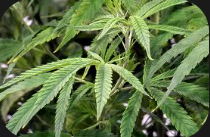
Buzzkill alert: a new study from the University of California San Diego shows some seriously high numbers, as Cannabis-related hospital visits for Golden State residents over 65 increased by a smokin’ 1,800 percent between 2005 and 2019.
UCSD geriatric medicine specialist and lead author of the paper Dr. Benjamin Han warns that it’s high time to point out that Grandma getting baked has risks:
“We don’t often think about older people using drugs but they do, and these numbers are increasing sharply,” Han said.
The problem? This isn’t Woodstock weed; today’s iterations are much more powerful.
“Many of them have experience in the past with cannabis and think they know how to use it and handle it, but oftentimes that’s not the case and they end up in the emergency department,” he said.
Seventy-year-old retiree Jill McDonald tried weed again after quitting many years ago and was unhappily shocked by how things have changed:
“Unsuspecting people think they’re doing little harm to themselves, when in actuality what is being offered is far more dangerous than our mellow weed from the past,’ she said.
“In 1995, America’s cannabis had an average strength of 4% THC, the active compound used to measure pot potency. The pot sold in California’s pot shops today often boasts potency over 40% THC, a 900% increase in THC potency.”
Most of the cannabis complications are “caused by injuries and falls, paranoia, cardiovascular trouble or cannabis interfering with other medications,” according to SFGATE.
Buzzkill alert: a new study from the University of California San Diego shows some seriously high numbers, as Cannabis-related hospital visits for Golden State residents over 65 increased by a smokin’ 1,800 percent between 2005 and 2019.
UCSD geriatric medicine specialist and lead author of the paper Dr. Benjamin Han warns that it’s high time to point out that Grandma getting baked has risks:
“We don’t often think about older people using drugs but they do, and these numbers are increasing sharply,” Han said.
The problem? This isn’t Woodstock weed; today’s iterations are much more powerful.
“Many of them have experience in the past with cannabis and think they know how to use it and handle it, but oftentimes that’s not the case and they end up in the emergency department,” he said.
Seventy-year-old retiree Jill McDonald tried weed again after quitting many years ago and was unhappily shocked by how things have changed:
“Unsuspecting people think they’re doing little harm to themselves, when in actuality what is being offered is far more dangerous than our mellow weed from the past,’ she said.
“In 1995, America’s cannabis had an average strength of 4% THC, the active compound used to measure pot potency. The pot sold in California’s pot shops today often boasts potency over 40% THC, a 900% increase in THC potency.”
Most of the cannabis complications are “caused by injuries and falls, paranoia, cardiovascular trouble or cannabis interfering with other medications,” according to SFGATE.
The study used government data from more than 300 hospitals statewide to measure emergency department visits between 2005 and 2019. The analysis found that 366 people over the age of 65 visited a California emergency department after using cannabis in 2005, but by 2019, that number was 12,167. The frequency of visits increased every year in the study, although the legalization of cannabis for recreational use in California in 2016 did not cause visits to increase at a faster rate.
While the numbers might be concerning, alcohol still causes far more senior ER visits, with over 187,000 admitted in 2020. Cannabis use has been rising among older people as more and more states (including California) have legalized marijuana, and pot advocates are more aggressively pushing its medicinal effects.
Spoiler Alert 🚨 Some of your favorite cannabis brands are just marketing companies. They don’t even grow or breed weed.
As I’m writing this, I realize I’m using the words “cannabis,” “pot” and “marijuana” interchangeably. However, that is not technically correct, so I bring you the true definitions courtesy of the Department of Health and Human Services:
The word “cannabis” refers to all products derived from the plant Cannabis sativa.
The cannabis plant contains about 540 chemical substances.
The word “marijuana” refers to parts of or products from the plant Cannabis sativa that contain substantial amounts of tetrahydrocannabinol (THC). THC is the substance that’s primarily responsible for the effects of marijuana on a person’s mental state. Some cannabis plants contain very little THC. Under U.S. law, these plants are considered “industrial hemp” rather than marijuana.
In other words, some cannabis products won’t actually get you buzzed, but if you smoke a joint, you’ll be on the moon. Now you know.
While the thought of grandpa smoking a blunt in the garage might be humorous to some, there are others who are harshly critical of its use. Before author Alex Berenson became a renowned COVID vaccine critic, he penned a book called “Tell Your Children: The Truth About Marijuana, Mental Illness, and Violence” in which he details “the link between teenage marijuana use and mental illness, and a hidden epidemic of violence caused by the drug—facts the media have ignored as the United States rushes to legalize cannabis.” Mother Jones wrote that the book “takes a sledgehammer to the promised benefits of marijuana legalization, and cannabis enthusiasts are not going to like it one bit.”
I’m not a fan. What it has done to relatives and friends. No one talks about the health problems and brain damage that is done…
I’m not one to get on a soapbox and tell people what they can and can’t do. But I can tell you that aging bodies don’t handle vices as well as young bodies do, so Grandma and Grandpa clearly need to slow their roll, with booze and with weed.
* Article from: Red State